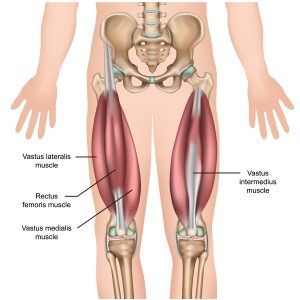Rectus femoris is the most superficial of the four quadriceps muscles, meaning it is located closest to the skin, above the other three The other quadriceps muscles are vastus medialis, vastus lateralis, and vastus intermedius. Of these four muscles, rectus femoris is the only one to cross both the hip and knee joints; the others cross only the knee. The various functions of this muscle give personal trainers important programming considerations to take into account when facing postural imbalances or knee/hip pain as well as maximal strength and endurance training.
Origin and Insertion
Rectus femoris uniquely has two points of origin: at the anterior superior iliac spine (ASIS) and posteriorly at the acetabulum (the socket of the hip joint). All four quadriceps muscles attach to the patella and the tibia through the quadriceps tendon.

Rectus Femoris Function
All quadriceps muscles extend the knee; rectus femoris is also involved in hip flexion. It is used frequently in daily movements like walking, rising up from seated, or climbing the stairs. It is also extremely active in sports that involve running, sprinting, or kicking a ball.
Training Rectus Femoris
Because the quadriceps are a large muscle group, it is beneficial to train them in a fashion that two-joint muscles like rectus femoris require; compound movements reign supreme when it comes to building overall strength and definition in major muscle groups.
Since this multi-joint muscle is the most superficial on the ventral thigh, those who want to see definition in their quadriceps should certainly target it. Additionally, weakness in the quads has been connected to knee pain and, more specifically, osteoarthritis in the knees.
*For most lower-body compound movements, a smaller hip angle (equating to greater forward hinging) will challenge the glutes more than the quads: to target the quads, instruct your clients to stay more upright when doing standing exercises.
[sc name=”functional” ]
The leg press is a favorite way to train rectus femoris with a compound movement. There are different machines set up with different angles; one in which the hip angle is short
Front squats are an accessible and functional way to strengthen the quadriceps and prepare them for basic movements in your client’s daily life. These can be done with or without weight, and could progress to jump squats over time.
Lunges, similar to squats in which muscles are worked, are a classic bodyweight exercise that primarily challenge the quadriceps. They can be progressed with the addition of dumbbells as your client builds strength, or in multiplanar positions. A Cossack lunge is a killer way to work the quads.
Step-ups are another functional way to train rectus femoris. Using just a step or a bench, clients can step up one foot at a time onto a platform, with or without weights. Over time, the height of the step or the bench may increase to progress this exercise.
Leg extensions most directly target the quadriceps; most gyms are equipped with a leg extension machine. Additionally, clients could try leg extensions with ankle weights if a machine is not available by standing on one leg and extending the other with the knee held at hip height. Additionally, sitting on the floor with the legs fully extended and attempting to lift a leg off the floor is an excellent way not only to rehab a knee joint, but to fully contract the rectus femoris, especially in an endurance range.
When targeting rectus, consider exercises that include both of its functions: hip flexion and knee extension.
Whether it’s for aesthetic or functional purposes, strengthening the quadriceps relies on the understanding of each of its muscles, and rectus femoris is significant.
[sc name=”anatomy” ]
References
Segal, N A et al. “Quadriceps weakness predicts risk for knee joint space narrowing in women in the MOST cohort.” Osteoarthritis and cartilage vol. 18,6 (2010): 769-75. doi:10.1016/j.joca.2010.02.002
Glass NA, Torner JC, Frey Law LA, Wang K, Yang T, Nevitt MC, Felson DT, Lewis CE, Segal NA. The relationship between quadriceps muscle weakness and worsening of knee pain in the MOST cohort: a 5-year longitudinal study. Osteoarthritis Cartilage. 2013 Sep;21(9):1154-9. doi: 10.1016/j.joca.2013.05.016. PMID: 23973125; PMCID: PMC3774035.
https://www.knee-pain-explained.com/rectus-femoris.html

